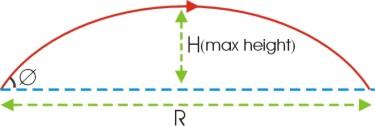Question #ddd99
1 Answer
At an angle of
Explanation:
When a projectile is launched at an angle, let's call it
Let's assume that the projectile is launched with an initial velocity of

Horizontally, the projectile is not acted upon by any force. This means that the vertical component of its initial velocity will remain unchanged during the motion.
This means that you can write
Vertically, things are not that simple. The projectile will be acted upon by the force of gravity, which means that the vertical component of its initial velocity will be affected by the gravitational accceleration,
Since the projectile starts at ground level and ends up on ground level, its horizontal displacement will be equal to zero. THis means that you can write
Solve this equation for
The only valid solution is
Replace
To get the maxium range, you need the maximum value of
The easiest way to figure this out is to use the following trigonometric identity
Since the maximum value of the sinus function is 1, you get
Take the arsin from both sides of the equation to get
Therefore,

